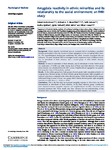Amygdala reactivity in ethnic minorities and its relationship to the social environment: an fMRI study
| dc.contributor.author | McCutcheon, R | en |
| dc.contributor.author | Bloomfield, MAP | en |
| dc.contributor.author | Dahoun, T | en |
| dc.contributor.author | Quinlan, M | en |
| dc.contributor.author | Terbeck, S | en |
| dc.contributor.author | Mehta, M | en |
| dc.contributor.author | Howes, O | en |
| dc.date.accessioned | 2018-01-19T13:02:28Z | |
| dc.date.available | 2018-01-19T13:02:28Z | |
| dc.date.issued | 2018-09 | en |
| dc.identifier.issn | 0033-2917 | en |
| dc.identifier.uri | http://hdl.handle.net/10026.1/10610 | |
| dc.description.abstract |
<jats:title>Abstract</jats:title><jats:sec id="S0033291717003506_sec_a1"><jats:title>Background</jats:title><jats:p>Ethnic minority individuals have an increased risk of developing a psychotic disorder, particularly if they live in areas of ethnic segregation, or low own group ethnic density. The neurobiological mechanisms underlying this ethnic minority associated risk are unknown. We used functional MRI to investigate neural responses to faces of different ethnicity, in individuals of black ethnicity, and a control group of white British ethnicity individuals.</jats:p></jats:sec><jats:sec id="S0033291717003506_sec_a2" sec-type="methods"><jats:title>Methods</jats:title><jats:p>In total 20 individuals of black ethnicity, and 22 individuals of white British ethnicity underwent a 3T MRI scan while viewing faces of black and white ethnicity. Own group ethnic density was calculated from the 2011 census. Neighbourhood segregation was quantified using the Index of Dissimilarity method.</jats:p></jats:sec><jats:sec id="S0033291717003506_sec_a3" sec-type="results"><jats:title>Results</jats:title><jats:p>At the within-group level, both groups showed greater right amygdala activation to outgroup faces. Between groups, the black ethnicity group showed greater right amygdala activation to white faces, compared to the white ethnicity group. Within the black ethnicity group, individuals living in areas of lower own group ethnic density showed greater right amygdala reactivity to white faces (<jats:italic>r</jats:italic> = −0.61, <jats:italic>p</jats:italic> = 0.01).</jats:p></jats:sec><jats:sec id="S0033291717003506_sec_a4" sec-type="conclusion"><jats:title>Conclusions</jats:title><jats:p>This is the first time an increased amygdala response to white faces has been demonstrated in individuals of black ethnicity. In the black ethnicity group, correlations were observed between amygdala response and neighbourhood variables associated with increased psychosis risk. These results may have relevance for our understanding of the increased rates of paranoia and psychotic disorders in ethnic minority individuals.</jats:p></jats:sec> | en |
| dc.format.extent | 1985 - 1992 | en |
| dc.language | en | en |
| dc.language.iso | en | en |
| dc.publisher | Cambridge University Press | en |
| dc.title | Amygdala reactivity in ethnic minorities and its relationship to the social environment: an fMRI study | en |
| dc.type | Journal Article | |
| plymouth.issue | 12 | en |
| plymouth.volume | 48 | en |
| plymouth.journal | Psychological Medicine | en |
| dc.identifier.doi | 10.1017/s0033291717003506 | en |
| plymouth.organisational-group | /Plymouth | |
| plymouth.organisational-group | /Plymouth/REF 2021 Researchers by UoA | |
| plymouth.organisational-group | /Plymouth/REF 2021 Researchers by UoA/UoA04 Psychology, Psychiatry and Neuroscience | |
| dcterms.dateAccepted | 2018-01-01 | en |
| dc.identifier.eissn | 1469-8978 | en |
| dc.rights.embargoperiod | Not known | en |
| rioxxterms.versionofrecord | 10.1017/s0033291717003506 | en |
| rioxxterms.licenseref.uri | http://www.rioxx.net/licenses/all-rights-reserved | en |
| rioxxterms.licenseref.startdate | 2018-09 | en |
| rioxxterms.type | Journal Article/Review | en |


